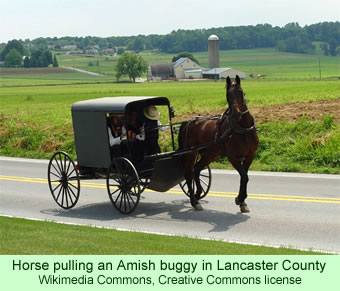Police last week identified a man whom they accused of shooting a horse that was pulling an Amish family in rural Lancaster County, Pennsylvania, back in November. The story highlights the continuing difficulties that some Amish have in dealing with their neighbors.
 On Sunday evening about 9:00 p.m., November 24, 2013, an Amish family—father, mother, and their three children—were driving their buggy north on North Ronks Rd, in East Lampeter Township when a car drove past them also heading north. They heard what they thought was a firecracker. They were about one-quarter mile north of the intersection with U.S. Rt. 30, one of the main thoroughfares for Amish tourism in the county, heading toward their farmhouse near the village of Ronks.
On Sunday evening about 9:00 p.m., November 24, 2013, an Amish family—father, mother, and their three children—were driving their buggy north on North Ronks Rd, in East Lampeter Township when a car drove past them also heading north. They heard what they thought was a firecracker. They were about one-quarter mile north of the intersection with U.S. Rt. 30, one of the main thoroughfares for Amish tourism in the county, heading toward their farmhouse near the village of Ronks.
The horse bolted but the man was able to get it under control. Only when they reached home did they realize that the horse was bleeding from its mouth. They spotted a wound in its chest and contacted a veterinarian, but before help arrived, the horse had died.
Lieutenant Robin Weaver from the East Lampeter Township Police Department, describing the incident to the news media, said that it is not uncommon for motorists to harass the Amish by throwing eggs, other food items, and firecrackers as they drive past their buggies. “They’re an easy target. They can’t fight back,” Weaver said. But in his 30 years of police work, he couldn’t recall another incident comparable to the horse shooting.
On Wednesday last week, police finally identified the accused assailant—Timothy Antonio Diggs, Jr, a 22 year old man who is also from Ronks. Police charged him with five counts of reckless endangerment and animal cruelty. At the time he was charged with the drive-by shooting of the Amish horse, he was already incarcerated in the Lancaster County prison on two separate burglary charges, one of which involved stolen guns.
The police did not reveal to the media if any of the stolen firearms found in the suspect’s apartment had been used to kill the horse in November, nor did they indicate if they had determined a motive for the shooting.
Although Lancaster county is home to thousands of Amish families, it can be hard to imagine why the “English” would harass them, as Lieutenant Weaver indicated. The police officer suggested that one reason may be their beliefs in pacifism. Perhaps when the case goes to a court trial, the nature of Mr. Diggs’ attitudes toward the Amish will become clear.
Since he is from the same village, he may know some of the Amish families in his community. According to the Wikipedia, Ronks has several Amish-themed restaurants, shops, and attractions. With a 2010 census population of only 362, many of the residents doubtless know one another.
Kraybill (1989) throws some possible light on the situation in Lancaster County. He writes that relations between the Amish and their non-Amish, “English,” neighbors have gradually become more distant as the decades have passed. One hundred years ago, rural Amish and English would have all sent their children to the same schools.
Before rural schools were consolidated, the kids would have grown up as acquaintances and friends. Amish men served on the boards of the one-room rural schools that children from both groups attended. They no longer do because the Amish refuse to allow their children to be bussed to schools outside their immediate communities.
Furthermore, the economies of the Amish farmers used to be integrated with those of the English, but that integration has lessened in some ways during the course of the 20th century as more and more Amish have also opened businesses. They use many products and services from the wider society, but their lives in some ways have become more remote from those of their neighbors.
Amish farmers can now purchase their supplies from Amish-owned farm supply companies. They can buy implements, dry goods, and groceries from Amish-owned stores—and they will do so. In sum, their day-to-day market transactions have moved from the broader county economy into the Amish enclave.
Kraybill points out that the Amish do, of course, participate to some extent in social activities that include the majority society, such as the volunteer fire companies that serve all rural areas of the county. They may attend some public events, such as baseball games, and they may travel to public parks or the Philadelphia Zoo for outings.
It is not yet clear if any of that explains why a lone gunman should take out his feelings on an Amish horse.